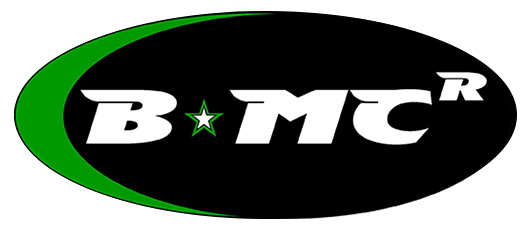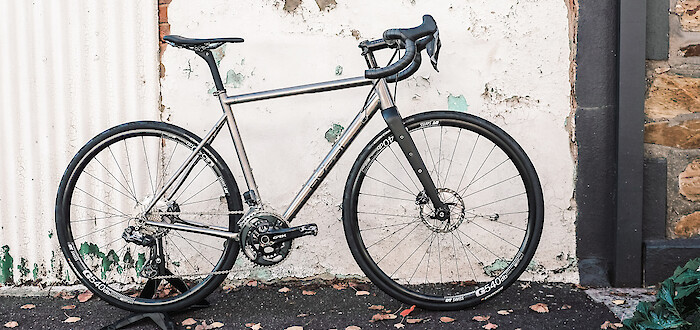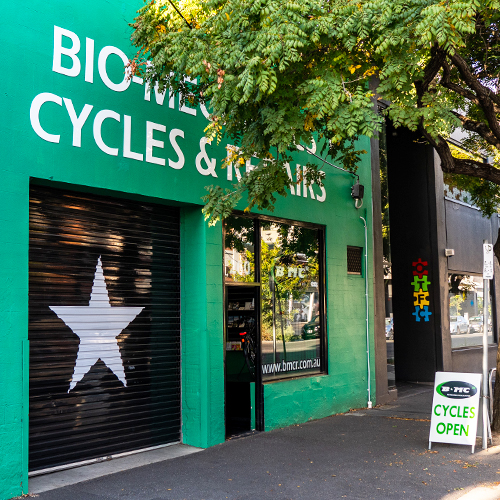Bicycle Tyre Puncture Repair: Your Ultimate Guide


How to repair a flat bicycle tyre, tubed or tubeless
So you're out on your bike and hear that dreaded 'ssssss'.
Or maybe it suddenly feels like you’ve got a hokkien noodle instead of a tyre.
Or something goes ‘bang!’ and it’s not your suspension.
Yup, you've got a puncture, and you're far from home. Now what?
Bicycle tyre puncture repair is an essential skill that any bike rider should know, and will save you a lot of time and aggravation.
The good news is that repairing a bicycle puncture isn’t complicated, whether you’re running tubes or tubeless. However, you do need to follow some essential steps.
We’ll also show you how to avoid the most common mistakes that can ruin your repair.
Tubeless peeps, you can jump straight to our tubeless flat tyre repair section.

What do I need to fix a flat tyre?
Your bicycle tyre puncture repair kit needs:
- Two tyre levers
- A tube
- Glueless patches
- A piece of high-density cloth (canvas = great, gaffa tape = acceptable; even a folded $5 note works in an emergency)
- If your bike has through-axles, a suitable Allen key
- A pump or Co2 inflator
No repair kit?
Phone for a lift, or start walking.
And while you’re walking, make a note to get a repair kit together when you get home.

OK, got your kit? Let’s get that tube replaced.
STEP ONE: REMOVE THE WHEEL
To fit a new tube, there’s no way around it: you will need to take the wheel off the bike.
If you don’t want to remove the wheel, you can always patch the tube while the wheel is still inside the frame, but it’s a pain in the butt so we don’t recommend it unless you have no alternative.
To remove the front wheel:
- Rim brake bikes: look for a small lever on the brake caliper or lever and flip it up to release the brake. Then undo the quick-release skewer, unwind the opposite nut, and lift the wheel out.
- Disc brake bikes with a quick-release skewer: open the quick-release lever (unwind the nut on the opposite side of the skewer if need be) and lift the wheel straight out.
- Disc brake bikes with through-axles: if it has a lever, unscrew it by turning it counter-clockwise until you can remove the wheel. If an Allen key is required, insert the key and rotate it counter-clockwise until the axle is free.
POTENTIAL PROBLEM AREA: ROUNDING OUT THE AXLE
Make sure the Allen key is inserted all the way in, and turn it firmly but smoothly. If the tool is loose or you’re too rough with it, you can damage the end of the axle, which can mean not being able to get the wheel out at all. So, yeah, don’t do that.

To remove the rear wheel:
- Change the gears so the chain is on the smallest rear cog. This reduces the chain tension plus makes it easier to remove and refit the wheel.
- Flip the bike so it’s upside down and resting on the saddle and handlebars.
Note: if you’ve got anything attached to your handlebars (e.g. lights/computers), remove or reposition them first so they don’t get damaged. If you do remove them, put them with your repair kit so you don’t ride off and leave them in the wilderness.
- Disc brake bikes: follow the same method as for the front wheel to remove the skewer.
- Rim brake bikes: release the brake lever and undo the QR skewer.
- Before you try to remove the wheel, push your rear derailleur slightly backward with one hand. Now use your other hand to pull the wheel straight out. Don’t let it hit the derailleur cage; the last thing you need is a gear catastrophe on top of a puncture.

STEP 2: WHY DID YOU GET A PUNCTURE?
Most punctures are caused by a sharp object—such as a thorn or piece of glass—or rim tape issues.
If you don’t discover (and fix) the problem, you run the chance of getting another puncture once you’re back on your bike.
Then you not only wasted your time changing the tube but now you need to do it again.
If you have a second tube.
Which you probably don’t.

To find the cause, you’ll need to investigate the tube, tyre and wheel.
Release one bead of the tyre by pushing the tyre sidewall toward the centre of the rim. Use your tyre levers to lift the tyre bead (the edge of the tyre) over the rim, starting with one lever and adding the second about 5 cm further along. Continue working the bead over the rim until you can pull the tyre completely off.
POTENTIAL PROBLEM AREA: NOT USING TYRE LEVERS
For the love of cheese, do not use a spoon, stick or screwdriver to take your tyre off the rim. They can easily damage the tube or rim. (And they just don’t work that well.)
A set of proper tyre levers will cost you a bit more than a coffee and a bit less than a beer. And far, far less than a new rim after you ruin your sidewall with a screwdriver.
Don’t be a cheapskate: buy a set of tyre levers and chuck them in your repair kit.
Now, let’s start by finding the puncture site. But wait…

POTENTIAL PROBLEM AREA: NOT NOTING THE VALVE POSITION
Before removing the tube, note where the valve lines up with the tyre. This will help you find the puncture point more easily. (It’s also why it’s a good idea to always line up your valve and tyre logo.) You can mark the sidewall at this point with your thumbnail or a stick so you can refer back to it.
Now, remove the tube from the tyre and look for the puncture site.
If you’ve checked it over but can’t see anything, inflate the tube and run your hand over it/pass it by your cheek to feel where the air is coming out.

Is the hole on the outside of the tube?
This means it was probably a thorn, glass, piece of wire, nail, road debris where council workers have just pushed stuff into the bike lane because they don’t seem to give even the TINIEST SHI—….
Sorry, where were we? Ah, yes.
Now inspect the puncture site on the tyre. (Use the valve location you marked before to match it up.) Check inside the tyre to make sure that no tiny, tube-destroying remnants remain. Squeeze this section to open up the crack and double-check.
Finally, carefully run your hand around the inside of the tyre (wear a glove, if you can) to ensure there’s nothing else lurking in there.
Is the hole on the inside of the tube?
Punctures on the inside edge of the tube often indicate issues with rim tape or spoke holes.
If your rim tape isn’t covering the spoke holes fully, the resulting abrasion can pop the tube.
Punctures can also be caused by sharp edges, especially near the valve hole.
Check your rim tape to ensure that it’s properly covering the spoke holes and hasn’t migrated or lifted away.
Are there two close holes rather than one?
Two holes that look like this indicate that the cause was a pinch flat.
A pinch flat (also called a snake bite -- guess why?) happens when your wheel hits something with enough force that it drives the tyre into the rim. The tube gets squished in-between the tyre and rim, and pops.
Fortunately, pinch flats are easily avoided by running high enough pressure in your tyres, and not smashing your bike into rocks or gutters.

STEP THREE: REPLACE THE TYRE AND TUBE
First, did you know that tyres are directional? (Many riders don’t seem to, judging by the number of bikes we see coming into the workshop with their tyres on backwards.)
To check which way it’s supposed to rotate, look at the tyre sidewall to see if there’s an arrow.
If there’s no arrow, check the tread. The pattern will usually point forward.

Now, fit one bead of the tyre back on the rim (lining the logo up with the valve hole) and get ready to install the tube.
POTENTIAL PROBLEM AREA: NOT INFLATING THE TUBE PRE-INSTALLATION
Do not try to install a completely flat tube. If you do, it can easily get caught between the tyre bead and rim. Then, when you inflate it, it’ll explode off the rim and give you a minor heart attack.
Instead, add a little bit of air to give it shape and make it easier to fit.

Insert the valve into the rim, then work the tube evenly into the tyre. Make sure it doesn’t twist. (You guessed it: twisted tube + inflation = explosion.)
If there’s a large cut in the tyre casing, use the cloth/tape/cash from your repair kit to cover the hole from the inside and help protect the new tube.
Now fit the second bead. Starting opposite the valve, use your hands to pop the bead over the rim. Work down one side, and then return to the starting position opposite the valve and work down the other side. If it gets too tight for you to continue fitting by hand, use your tyre levers but be very careful not to pinch the tube.
POTENTIAL PROBLEM AREA: NOT CHECKING THE BEAD
If any part of the tube is caught between the bead and the rim, it will (say it with us) explode when you inflate it. You need to seat the tyre properly to ensure this won’t happen.
Stand over the wheel so you can look straight down at the tread. Starting opposite the valve, compress the sidewalls together and check that the tube isn’t poking out. Check down one side then the other, using a rolling motion to make sure the tube is sitting completely inside the tyre.

Once you’re confident it’s correctly fitted, now you just have to inflate it, right?
Not so fast.
POTENTIAL PROBLEM AREA: NOT SEATING THE VALVE
There’s one final, crucial step before you inflate your tyre. You must seat the valve. To do this, push the valve stem up into the tyre and pull it back down again.
If you can’t push the valve up, check the area inside the rim to ensure there’s no tube material caught between the bead and rim. It may just be that you have to push harder; sometimes using the tyre lever is helpful (especially if you don’t have super-strong hands).
Once the tube is properly positioned, push the valve in then pull down to seat it.
You can inflate the tyre now or once the wheel is fitted (which is sometimes easier if you’ve got rim brakes).
Either way, make sure to pump up the tyre to the recommended PSI, as running half pressure almost guarantees another flat.

STEP 4: REPLACE THE WHEEL
This is easy: just reverse the steps you took beforehand to remove it.
Once fitted, don’t forget to:
- Do up the brake lever release again (if you have rim brakes).
- Check that the quick release skewer/through-axle is done up firmly.
- Not leave any bits and pieces behind on the roadside/trail/fire road.
Congratulations! Now finish your ride.
And don’t forget to put a fresh tube in your repair kit when you get home.
Tube repair FAQs
Can I repair a flat tyre without removing the rear wheel?
Yes. You can patch the punctured tube instead of replacing it, but it’s a lot fiddlier. Also, removing a wheel is a basic skill that every rider should know how to do, so learn how to do it and save yourself the fiddling.
What do you need glueless patches for?
Glueless patches should only be used as a back-up. They’re are basically designed to get you home, and will never work as well as traditional patches with glue.
However, if you’re in a situation where you have to use one (such discovering that your spare tube is no good, or you get a second puncture), remember to clean the area before applying the patch.
Can you fix a flat tyre without a repair kit?
It depends how desperate you are. If you’re really in trouble, you may be able to stuff your tyre with something such as grass so its rideable until you’re back to an area with phone reception.
If you’re at this point, though, in all honesty you probably have larger problems to deal with.

HOW TO FIX A TUBELESS FLAT TYRE
There are pros and cons to running a tubeless system, but one of the major pros is puncture repair:
- It’s faster.
- You don’t have to remove the wheel or tyre.
- You can carry fewer spares.
After all, the tubeless sealant takes care of most of the small punctures that would derail a tubed setup, which is the whole point of it.
While the procedure to repair a tubeless tyre is therefore a lot simpler than a tube replacement, there are still some potential problem areas to avoid.
For tubeless setups, your puncture repair kit needs:
- Tyre plugs with installation tool
- A Co2 inflator

STEP 1: WHY DID YOU GET A PUNCTURE?
As with tubed tyres, it’s important to know what caused the flat.
The most common reasons for a flat tyre on a tubeless setup are:
- Something’s punched a hole in the tyre that’s too large for tubeless sealant to fix.
- Something’s ripped or cut the tyre sidewall; most tubeless sealants aren’t able to seal sidewall cuts.
- You’ve hit an edge, root or jump too hard and the tyre has briefly separated from the rim to let the air out (also called ‘burping’).
- The wheel hasn’t been set up correctly. Air can leak if the tyre isn’t seated properly. Air and/or sealant can also leak through the spoke holes if the rim tape isn’t correctly installed.
- Your sealant has dried up, so there’s no liquid to seal any punctures.
Most of the time, it’ll be one of the first two. The easiest way to spot this is to spin your wheel and look for an area where sealant has sprayed out or is still bubbling.

POTENTIAL PROBLEM AREA: NOT REMOVING DEBRIS
If there’s still glass, metal or debris in the hole, even the best tubeless plug won’t work.
Check the hole thoroughly to make sure there’s nothing still stuck in there. Squeeze the tyre to open the area up and make sure.
STEP 2: SEAL THE HOLE
Regardless of what kind of tubeless tool you’re using, the vast majority operate the same way.
Take the tool and thread the replacement plug (or ‘bacon strip’, because god knows this industry loves a nickname) into the head.
Push the tool into the hole, making sure to keep it perpendicular to the tyre, and stop when you’ve got about 1cm of plug left on the outside.
Carefully remove the tool and then use your Co2 inflator pump to reinflate the tyre. Make sure you’re taking it up to the correct PSI to help the plug settle in.
Now spin the wheel again so the sealant can help coat the plug.

POTENTIAL PROBLEM AREA: PLUGGING IMPATIENTLY
When it comes to removing the tubeless tool, go slow and steady. If you rip the tool out of the tyre, you can either take the plug with it or not install it deep enough to work.
Make sure to slowly pull the tool out, keeping it straight, so the plug stays intact and properly seals the tyre.
POTENTIAL PROBLEM AREA: USING THE WRONG SIZE PLUG
Plugs come in different sizes – smaller ones for road tyres and larger ones for mountain bike and gravel tyres. Make sure yours is correct for the tyre you’re fixing. In a pinch, you can double up two small ones if you have to.

Tubeless repair FAQs
Do you need to trim tubeless plugs?
You can trim the plug if there’s a lot sticking outside the tyre; otherwise, just ignore it and it will wear down as you’re riding.
Should I take a spare tube?
Ideally, you run tubeless so you don’t have to deal with tubes at all, but if you’re unfortunate enough to get a hole that your sealant can’t fix due to size or placement (or if you find your sealant has dried up or your rim tape isn’t holding air), a spare tube is a good idea for a back-up.
Note: you’ll still need tyre levers and a pump to install it, so if your priority is travelling light, you may decide to skip it all together and take the risk of getting stranded.

And that’s your full puncture repair guide!
Whether you’re running tubes or a tubeless setup, a flat tyre doesn’t have to mean the end of your ride. With a couple of tools, you’ll be able to get yourself back up and running.
And if it all sounds too much or you’re having repeat problems, bring it in to us and we’ll sort it out for you.


